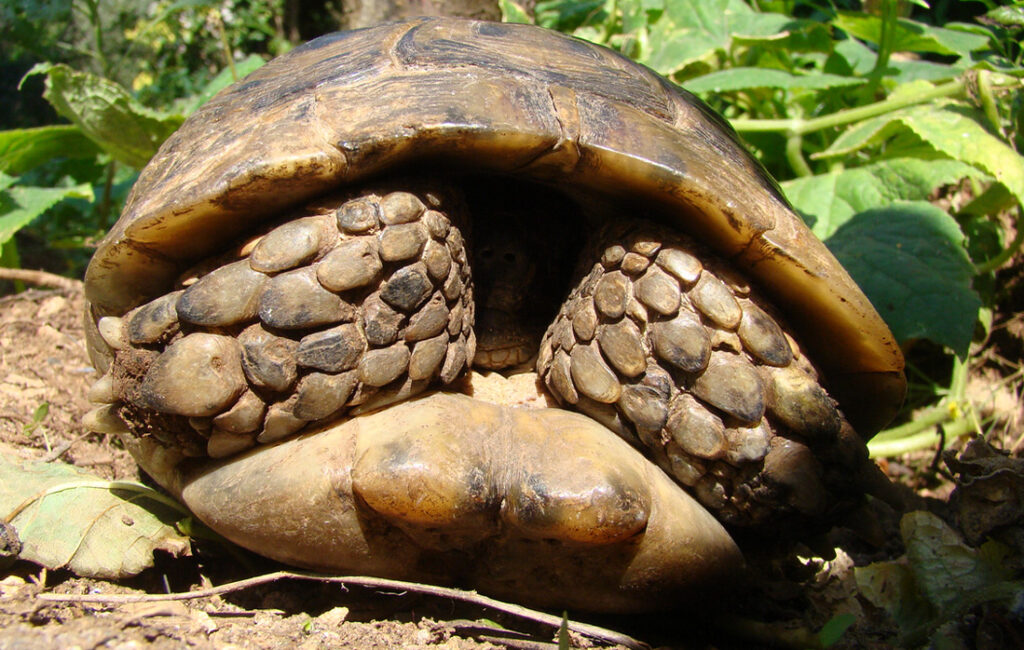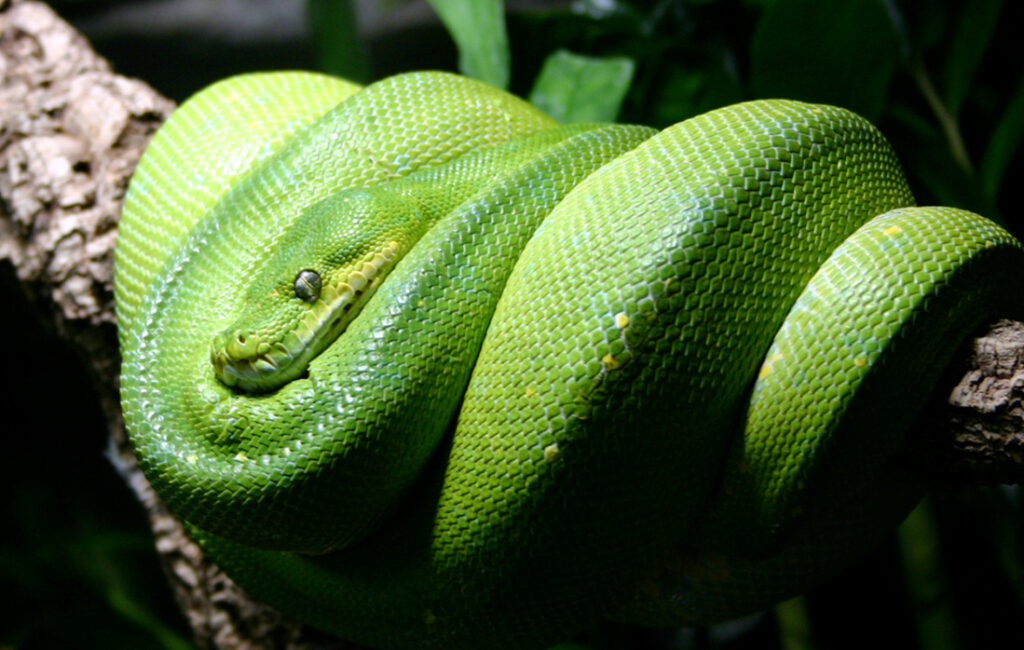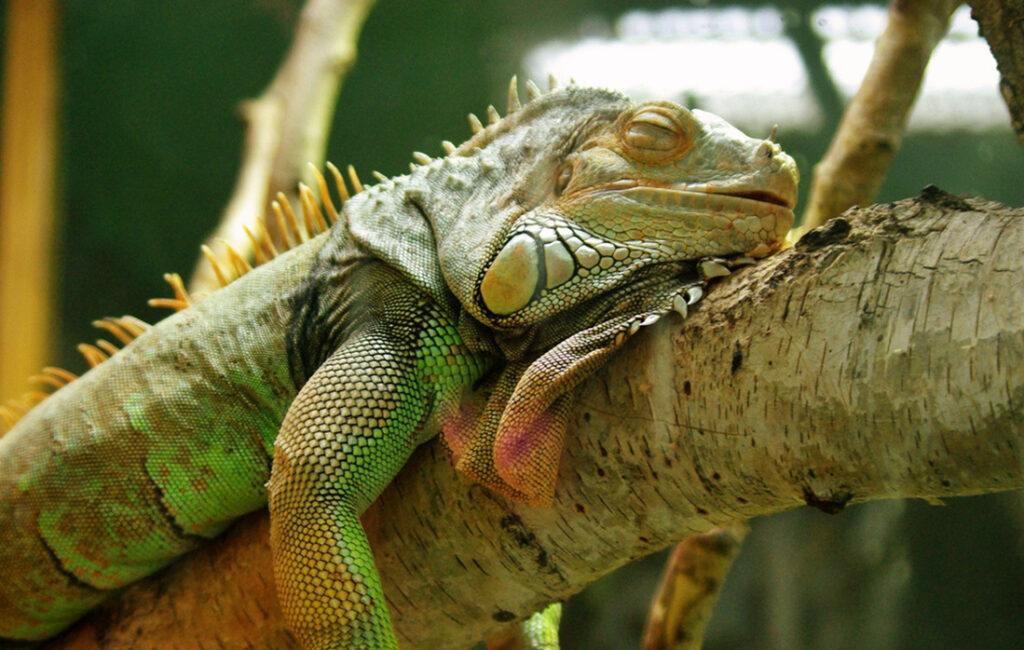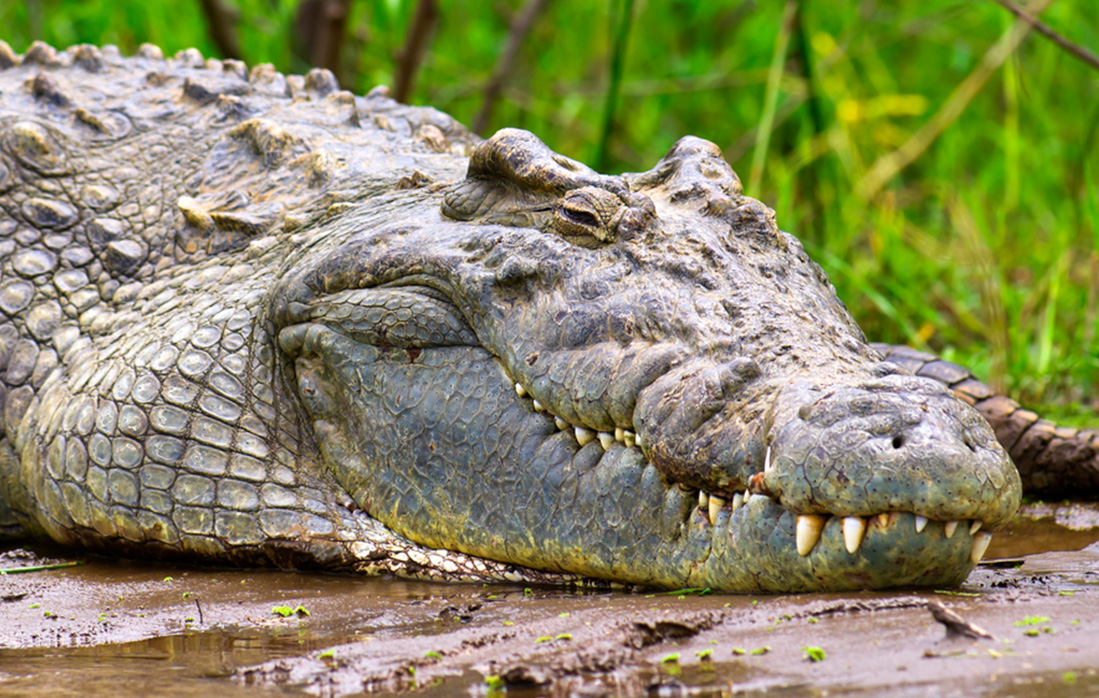Sleep is a vital part of the 24-hour rhythm of many animals, including humans. While it’s easy to see that pets like cats, dogs and even parrots sleep, the biology behind reptile sleeping is harder to pinpoint.
Do reptiles sleep the same way as humans? How can snakes sleep without eyelids? Is your leopard gecko dreaming when it sleeps? Researchers are still uncovering the answers to these questions and more.
In this article, we’ll break down the science behind reptile sleep, including how long different species sleep, whether or not reptiles dream and if they follow the same sleeping patterns as us.

Do All Reptiles Sleep?
Sleep is a basic function for all reptiles, from your own pet corn snake to wild crocodiles. In fact, we are finding that more and more groups of animals sleep, suggesting that it evolved millions of years before the ancestors of both reptiles and mammals!
Reptile Sleep Patterns
There is still much we don’t know about the sleeping patterns experienced by reptiles. However, research on bearded dragons showed that they had two distinct stages of sleep: a slow-wave stage and a REM-like stage.
The slow-wave stage is characterized by low frequency, high amplitude brain waves, interrupted by occasional bursts of neuron activity. In contrast, brain activity during the REM stage is similar to being awake. This stage is also characterized by rapid eye movements. As the bearded dragons in the study slept, they cycled between these two phases about every two minutes.
When measured by an EEG machine (which records electrical activity in the brain), the brain activity of sleeping reptiles looks different from EEGs of sleeping mammals. Though mammals and lizards have similar sleep stages, they are still very different from one another.
Can Reptiles Become Sleep Deprived?
It is not positively known whether or not reptiles can become sleep deprived, but so far the answer seems to be yes. Reptiles will sleep longer and deeper after being deprived of sleep, indicating that their bodies will try to make up for lost sleep time.
It’s important that pet reptiles get several hours of quiet time for sleeping to reduce stress and regulate their circadian rhythms.
Snakes
How Do Snakes Sleep?
Do Snakes Sleep with Their Eyes Open?
Snakes don’t have eyelids, so they have to sleep with their eyes open. Despite this, their brains still shut down when sleeping, just like other animals. A sleeping snake may look like it’s glaring at you, but it’s actually unconscious!
How to Tell if a Snake Is Sleeping
It can be tricky to tell if a snake is asleep because it can’t close its eyes. Some clues you can look for instead include:
- Sitting still for hours at a time
- No tongue-flicking
- Slow, deep breathing
- No reaction
How Long Do Snakes Sleep?
Snakes spend much of their time sleeping. On average, snakes tend to sleep about 16 hours per day, though some species can sleep up to 22 hours a day!
In fact, some species of snake brumate (or go dormant) during the winter for as long as eight months.

Where Do Snakes Sleep?
Where a snake sleeps depends on its lifestyle. Arboreal and semi-arboreal species (think of tree snakes and ball pythons) usually sleep draped or coiled over tree limbs and branches.
Ground-dwelling species like sand boas and garter snakes prefer to sleep in piles of debris or under the substrate.
Overall, snakes prefer to sleep in quiet, secure places where they feel safe from predators.
When Do Snakes Sleep?
Unlike us, not all snakes sleep at night. Nocturnal snakes are most active after dark and sleep when it’s light outside. Diurnal snakes are the opposite, preferring to sleep at night.
If you own a ball python, milk snake or rainbow boa, chances are you’ve noticed how your pet becomes most active when the lights are off. Conversely, rat snakes and corn snakes go to sleep in the evening and resume their activities in the morning.
Lizards
How Do Lizards Sleep?
Do Lizards Sleep with Their Eyes Open?
Most lizards have eyelids and close their eyes when they sleep. The only group of lizards that don’t have eyelids are the geckos, which are lizards in the infraorder Gekkota. All gecko species (except for leopard geckos and their close relatives) don’t have eyelids. These lizards sleep with their eyes open, though they are still unconscious.
How Long Do Lizards Sleep?
Lizards are a huge group of reptiles with over 7,000 species, and their sleeping habits are just as diverse. The amount of time a lizard sleeps depends on its species, along with environmental factors like time of year, temperature and food availability.
Lizards sleep for as short as just four hours a day to over 18 hours. Lizards in cold climates brumate (a less deep sleep than hibernation) for several months until it warms up again.
Where Do Lizards Sleep?
Lizards will sleep almost anywhere they feel safe and comfortable. Smaller lizards tend to hide in cracks and crevices where they can’t be reached by predators, while large lizards with few predators, like monitors and Komodo dragons, will sleep in more open areas.
Do Lizards Sleep on Walls?
Some arboreal lizards will sleep on walls, though this is a rare site. Mediterranean house geckos are one species that live in and around buildings. They are seen out on walls at night but will sleep under awnings and in house sidings during the day.
When Do Lizards Sleep?
Diurnal (day-active) lizards sleep at night. Nocturnal (night-active) lizards sleep during the day. This trade-off helps prevent different lizard species from competing with each other for food and resources.

Turtles
How Do Turtles Sleep?
Do Turtles Sleep in Their Shell?
Maybe you’ve heard the myth that a turtle can leave its shell. However, this is entirely false! The backbone and rib cage of a turtle is connected to its shell. This means that they can’t come out of their shells. Turtles sleep, eat and breathe in their shells. Many turtles will pull their head and limbs into their shell for protection when sleeping.
Do Turtles Sleep with Their Eyes Open?
Turtles close their eyes when they sleep and often tuck their head into their shell or under their arm. Since turtles are generally not very active, you might see them sitting with their eyes open for several hours at a time. These turtles aren’t sleeping, only resting.
How Long Do Turtles Sleep?
Pet turtles usually sleep in short naps throughout the day, while aquatic turtle species will sleep for four to seven hours at a time. The length of time a turtle sleeps depends on the time of year and weather. Turtles tend to be more active in the warm spring and summer months.
Where Do Turtles Sleep?
Land-dwelling turtles like to sleep under low plants or fallen logs. As pets, you’ll find them sleeping in a hide or the corner of their enclosure.
Do Turtles Sleep Underwater?
Aquatic turtles prefer to sleep in the water. Some species like to bury themselves into the mud, while others will float on the surface with just their snout poking up. Since they still need to breathe air, aquatic turtles that sleep underwater will periodically come to the surface to take a breath.
Alligators
How Do Alligators Sleep?
Do Alligators Sleep with Their Eyes Open?
Alligators sleep with their eyes closed. When resting (but awake), they sometimes will just close their protective inner eyelid, called a nictitating membrane. This membrane protects their eyes underwater while still letting them see. When alligators sleep, they close their nictitating membranes and their true eyelids.
If you see an alligator with only its nictitating membranes closed, it’s not sleeping. It could either be temporarily resting or getting ready to go underwater. An alligator that is truly sleeping will have its eyelids fully shut.

Do Alligators Sleep on Land or in Water?
Alligators are masters of holding their breath (they can stay underwater for two hours straight). Though this is impressive by our standards, it’s not long enough to let an alligator sleep underwater.
Gators prefer to sleep on land, either in burrows or on the banks of wetlands, rivers and lakes. Fallen logs, boat docks and jetties are also favorite sleeping spots for alligators.
They like to sleep on land, but alligators can take brief naps while floating in the water. They are naturally buoyant, so they can float on the surface with very little effort.
How Long Do Alligators Sleep?
Alligators are not very active and spend much of their time sleeping and basking. In fact, an alligator may spend 17 out of every 24 hours sleeping! Because they have such slow metabolisms, these reptiles can go for up to a year between meals. This means they can afford to spend so much time sleeping instead of looking for food.
Crocodiles
How Do Crocodiles Sleep?
Do Crocodiles Sleep with Their Eyes Open?
Amazingly, crocodiles can do something many animals can’t: sleep with one eye open. Researchers found that crocodiles can sleep with one half of their brain at a time, keeping the other half awake. This means they can keep a lookout of their surroundings with one eye while still getting enough sleep. When one half of their brain is rested enough, they will switch over to sleep with the other half.
Do Crocodiles Sleep with Their Mouths Open?
In warm weather, crocodiles often sleep or rest with their mouths open. This behavior helps them cool down and avoid overheating, similar to a panting dog.
Crocodiles have large, broad snouts. The increased surface area helps to release excess body heat. Crocs often sleep with their mouths open to make sure they don’t get too warm while resting out of the water.
Do Crocodiles Sleep on Land or in Water?
Crocodiles sleep on land but may nap in the water, just like alligators. Sleeping on land lets them sleep longer hours without needing to worry about waking up to breathe. However, they rarely sleep very far from a source of water. If startled or threatened, crocs will quickly run or slide back into the nearest waterbody.
How Long Do Crocodiles Sleep?
Crocodiles have similar metabolisms to alligators and sleep about the same amount, anywhere from 10 to 17 hours per day. They may sleep even longer after eating. Like other carnivorous reptiles (including your own pet leopard gecko), crocodiles need heat to digest large meals. After a large meal, a crocodile will find a warm, sunny spot to bask in and may sleep for nearly a day!
FAQs
How do reptiles sleep without eyelids?
Some reptiles, notably snakes and geckos like crested geckos and leachies, don’t have eyelids. Instead, they have a clear, tough membrane that covers and protects their eyes.
However, this doesn’t mean they don’t sleep. When a reptile feels tired, it simply lies down and goes to sleep without needing to shut its eyes. Though it may look awake, a sleeping reptile isn’t aware of its surroundings.
Do reptiles dream?
So far, we only have evidence of dreaming in some reptiles. Dreaming occurs in REM sleep, and this has only been documented in lizards.
Do reptiles have REM sleep?
Lizards have been shown to have REM sleep stages. Other reptile groups, like crocodiles, snakes, and turtles, may or may not have REM sleep as well.
Many studies over the years have claimed to either have observed REM sleep or disproven it. Future research is needed to be able to confidently tell whether more reptiles have REM sleep.
Does temperature affect reptile sleep?
Temperature affects many aspects of reptiles’ metabolisms and behavior, but it doesn’t seem to affect their sleep. A study published in the journal Nature found that the sleep patterns of a bearded dragon relative didn’t change in response to temperature fluctuations.
